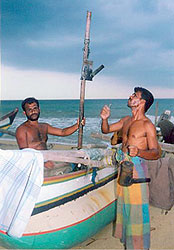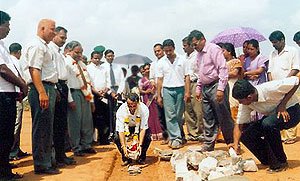
Maruthamunai‚ in the far north of Ampara District, is the only village producing handloom garments in the District and is very well known in Sri Lanka for its handloom products. It is said that the handloom industry in this region originated as far back as the 18th century, and that people here produced garments for the Kandian nobles. However, the handloom industry has suffered gravely due to various factors in the past and its continuing survival in the face of many barriers is amazing.
The period between 1970-1978 was a very successful time for the handloom industry and it flourished, with increasing numbers of young men and women taking to handloom weaving. During this time there were 6,300 handlooms and more than 10,000 people employed in this industry in Maruthamunai alone. A significant factor in this blossoming was the banning of textiles imports by the government at that time.
In 1978, a cyclone struck Maruthamunai and destroyed many handlooms. Subsequently, the liberalisation of imports and the lifting of the ban on textiles imports by the government also affected the industry, and handlooms here were reduced to 400 during the period of 1992-1994. This reduction in handlooms created unemployment problems for both men and women, who were compelled to look for greener pastures elsewhere. For some, the Middle East became the land of opportunity, and many went there for employment. As more and more handloom weavers started to migrate to the Middle East for employment, the number of handlooms in Maruthamunai was reduced to only forty by 1999. Thankfully, in 2000, professionals who were worried about the fate of the industry grouped together to form the Maruthamunai Peoples Development Company (Pvt.) Ltd. (MDCP) with hopes of reviving handloom weaving.
With assistance from the government and others, the MDCP showed Maruthamunai handloom products at exhibitions, organized by the company itself and others, in the Bandaranaike Memorial International Conference Hall (BMICH) in Colombo. These efforts brought dividends for the company and increased prosperity for the handloom industry in Maruthamunai. At this time, there was a great demand for Maruthamunai handloom products not only in Sri Lanka but also in some foreign countries, and the MDCP had to do everything it could to increase production in the area. The number of looms in Maruthamunai rose to 1,020 in 2004, just before tsunami devastated Ampara District.
In addition to the great loss of life, the 2004 tsunami also destroyed Maruthamunai handlooms thereby shattering the livelihoods of most of the workers in this industry. In response, international NGOs (INGOs) working in Ampara District provided the affected weavers with looms and other accessories required for their work, some through the MDCP and others directly. At present, there are around 600 looms in Maruthamunai, most of them supplied to weavers by local and international NGOs working in the District.

The Managing Director of MDCP, Dr. SMMS Umar Moulana, explains that “there is a great demand for Maruthamunai handloom products in the market, and the company has large orders to attend to... (However) the company is finding it difficult to cope with the demand given the lesser number of looms available”. He vowed to increase the number of looms to the previous level of 6,300, even though MDCP lacks the financial capacity to do so at present. “The company is currently running with a rolling capital of Rs. 2.5 million when it requires 15 million. Banks are not in a position to grant us loans, as we do not have non-movable assets to mortgage”.
With the assistance provided by local and international NGOs, handloom weaving in Maruthamunai is recovering bit by bit and is expected to improve more in the time to come. Weavers here are hopeful of a better future and the present demand for handloom products locally and overseas is encouraging.
NOTE: A tsunami-affected weaver woman who obtained assistance for weaving through MDCP has been selected for Women’s Entrepreneurship Award by the Chamber of Commerce this year. She was honoured with prizes at a function held at the Cinnamon Grand hotel in Colombo on the 16th of May, 2006. For more details, please see our June 4th, 2006 posting entitled “Women’s Entrepreneurship Award”.




